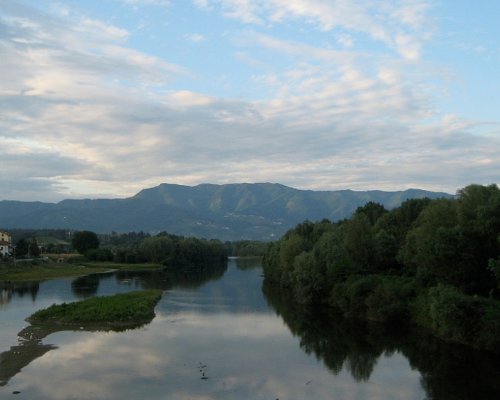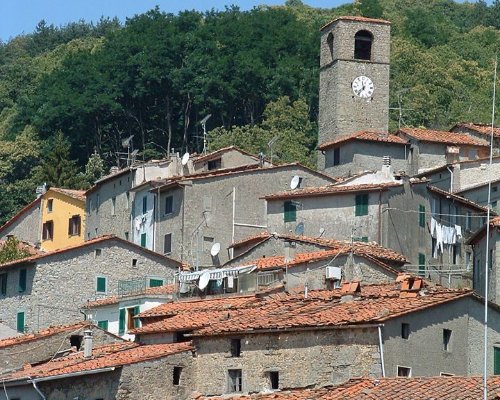A tour of the Serchio Valley, crossing the upper plains of the Pizzorne
An itinerary that takes you on a journey through the Serchio Valley, climbing hills dotted with villas and farms, before arriving in dense conifer and chestnut woods. The roads and the small, narrow-laned hilltowns that feature on the upper plains of the Pizzorne testify to the great importance that the area once had, crossed by those traveling towards the Apennine passes. The churches, refuges and guest houses that surround the beautiful little towns are also a witness to this.
The itinerary starts from Ponte Moriano, goes up to the Pizzorne hills, and then descends towards the Pescia di Collodi valley. The road is abandoned at the height of the hamlet of Pracando, to proceed up the plateau to Boveglio and then descend into the Lima Valley, ending the journey in Bagni di Lucca.
The route starts at Ponte a Moriano, the bottleneck that marks the entrance to the Serchio Valley.
The first sto is stop is Matraia.
The Matraia stone is one of the materials that distinguishes the civic architecture of the Pizzorne: large merchant residences and country churches, for example. This ia a grey, clear-toned sandstone, that has been widely used across the ages as a building material, not least in the finishing on balconies, windows and door portals, despite being highly susceptible to atmospheric conditions.
The route starts at Ponte a Moriano, the bottleneck that marks the entrance to the Serchio Valley.
The first sto is stop is Matraia.
The Matraia stone is one of the materials that distinguishes the civic architecture of the Pizzorne: large merchant residences and country churches, for example. This ia a grey, clear-toned sandstone, that has been widely used across the ages as a building material, not least in the finishing on balconies, windows and door portals, despite being highly susceptible to atmospheric conditions.
From the top of the hill of Pietra Pertusa, the view takes in the soft highlands of the Apennines and the harsher slopes of the Apuan Alps, as well as the Pisan hills, the coast and the luminous skyline on the Tyrrhenian sea. The oldest finds in this area are some small flint tools, dated to the Paleolithic era. A circular stone construction, built around decorated pillars, suggests rituals similar to Celtic ones.
Today this is a paradise for paragliding lovers.
From the top of the hill of Pietra Pertusa, the view takes in the soft highlands of the Apennines and the harsher slopes of the Apuan Alps, as well as the Pisan hills, the coast and the luminous skyline on the Tyrrhenian sea. The oldest finds in this area are some small flint tools, dated to the Paleolithic era. A circular stone construction, built around decorated pillars, suggests rituals similar to Celtic ones.
Today this is a paradise for paragliding lovers.
Continuing onwards, the route arrives to the Crocifisso Hermitage, built in the seventeenth century to house a cross that was miraculously discovered in the wood; it's surrounded by centuries-old oaks and an enormous horse chestnut tree.
Continuing onwards, the route arrives to the Crocifisso Hermitage, built in the seventeenth century to house a cross that was miraculously discovered in the wood; it's surrounded by centuries-old oaks and an enormous horse chestnut tree.
Among the many chapels that can be found in and outside the village of Boveglio, the Pancina Chapelis the most famous one; it has a bas-relief of an ox, as does the fountain in the piazza and the baptismal font in the church of San Jacopo and San Ginesio.
Among the many chapels that can be found in and outside the village of Boveglio, the Pancina Chapelis the most famous one; it has a bas-relief of an ox, as does the fountain in the piazza and the baptismal font in the church of San Jacopo and San Ginesio.
In 1581 Michel de Montaigne visited Benabbio and declared it a “fine and beautiful village”. In the fourteenth century the area was ruled from the castle of the Lupari, the local lords, but they were eventually hounded from Lucca by Castruccio Castracani and forced to took refuge in Bologna.
The parish church of Santa Maria Assunta is home to an extremely precious triptych, painted in 1469 by Baldassare di Biagio.
In 1581 Michel de Montaigne visited Benabbio and declared it a “fine and beautiful village”. In the fourteenth century the area was ruled from the castle of the Lupari, the local lords, but they were eventually hounded from Lucca by Castruccio Castracani and forced to took refuge in Bologna.
The parish church of Santa Maria Assunta is home to an extremely precious triptych, painted in 1469 by Baldassare di Biagio.
The journey finishes at Bagni di Lucca, a place noted since antiquity for its health-giving thermal waters, of which so many famous historical characters have been enamoured. It is said that they even delighted Dante, who reputedly drew inspiration for his Inferno from the Orrido di Botri.
The journey finishes at Bagni di Lucca, a place noted since antiquity for its health-giving thermal waters, of which so many famous historical characters have been enamoured. It is said that they even delighted Dante, who reputedly drew inspiration for his Inferno from the Orrido di Botri.


